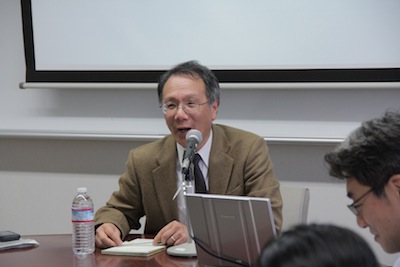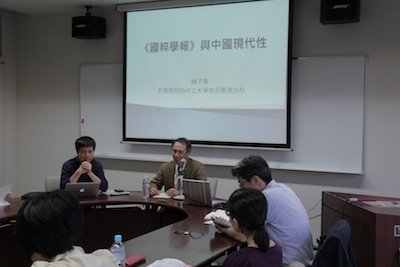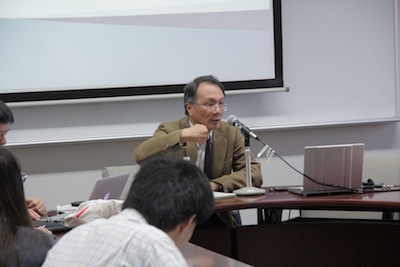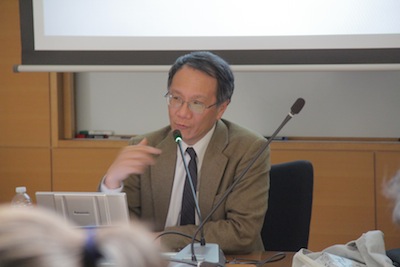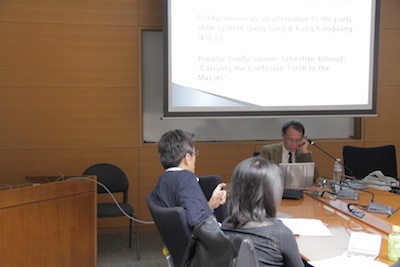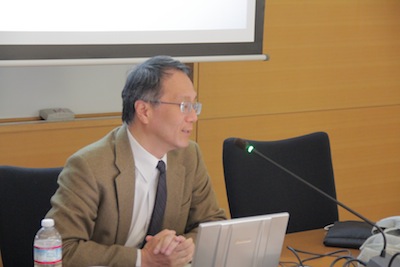[Report] Lecture by Prof. Hon Tze-ki
On October 14th and 15th, UTCP hosted the lectures delivered by Prof. Hon Tze-ki from SUNY. The lecture on 14th titled "Guo qi xue bao and Modern China" was given in Chinese and the one on 15th titled "Contemporary New Confucianism from 1980s to 1990s and East Asian Capitalism" was in English. So, in the followings, the lectures on 14th is reported in Chinese, and the 15th one is in English.
The Lecture on 14th
对韩子奇教授的“《国粹学报》与中国现代性”演讲会,本人报告如下。
“晚清国粹派”
主要成员有邓实(1877-1951)、黄节(1873-1935)、陈去病(1874-1933)、黄宾虹(1865-1955)、刘师培(1884-1919)、马敍伦(1884-1970)、章太炎(1869-1936)。他们结成“国学保存会”,出版《国粹学报》;宣扬国学,主张“辨华夷”、“西来说”(中国人的先祖是从巴比伦来)。
为何“国粹派”总被视为保守?
“辩华夷”,是 “晚清国粹派”对民族主义所抱的立场和态度。他们的民族主义是以汉族为中心,认为中国是汉族人的中国,坚决排斥满洲、蒙古、匈奴、鲜卑、契丹、沙陀等异族。他们认为,中国近代的积弱是由于长期受到异族的统治,汉族人受到无情的压迫,无法施展所长。从理念到内容,“晚清国粹派”的“大汉民族主义”都与辛亥革命后孙中山提倡的“五族共和”背道而驰,难免给人顽固守旧、落后保守的印象。
除了以上所述的顽固民族主义,“晚清国粹派”还给人以固守传统文化、文言、国学的印象。
中心论点
现代性(modernity)有两歧性。一方面,在科技、管理、运输、军械生产各个领域,欧洲人确实在领导全球,推动世界发展。他们近三百年来的科技发展,正带领全球人类进入新
的时代。另一方面,欧洲人特意利用现代“文明”,持势凌人,用武力侵略别国,在世界各
地建立殖民地,扩张自己的势力范围。
重看“晚清国粹派”
晚清国粹学派活动的背后,涌动着当时世界潮流。第一是印刷资本主义。《国粹学报》的出现,正是全球化资本主义体系在中国拓展的一个表现。首先,出版《国粹学报》的“国学保存会”,会址设在上海英租界四马路老巡捕房东面的惠福里。清末时期的上海四马路布满印刷所、书店、杂志社和售卖“文房四宝”的商店。故此,四马路俗称“文化街”,是“新型文
化人”以商业手法兴办文化事业的地方。与其他文人学会一样,“国粹保存会”借助外国人
的势力,在租界从事商业性的文化事业。
第二是想像的共同体。宣扬汉族文化的精髓的目的是为了建立民族国家(nation-state)
证明中国虽然是一个多民族帝国,它可以被改造为现代的“想像的共同体”(imagined
community)。
对“西来说”的普遍误读
第一是认为其 搭乘“欧洲中心论”文化霸权的便车。“晚清国粹派”不了解“西来说”是伴随西方帝国主义高度扩张,所产生之“欧洲中心”(Euro-centric)的文化霸权论述。
第二是认为其经不起考古实证研究的检验。批评认为,西来说所蕴含的种族偏见与虚构性,在目前考古实证研究的检验下,殆已昭然若掲。
对“辨华夷”的普遍误读
“晚清国粹学派”的“辨华夷”,虽然一方面包含大汉民族主义、打压少数民族、中国中
心论、强烈的排他性,但另一方面是要为中国谋出路,希望通过“辨华夷”去解决当时中国所
面临的问题。
“西来说”与“辨华夷”的关系
大汉族主义的两歧性。突出自我,融入世界。西来说证明汉族黄种人和欧洲白种人在远古时代都源于西亚细亚,同样是“文明之裔”,有条件领导人类进化。“晚清学派”从汉族文化中找出证据,证明汉族已经具备了进入“民族国家”的能力,所差的只是解除宗法政体的束缚,当推翻了宗法制度之后,汉族人便能马上建立现代的“民族国家”。
西来说把中国纳入全球化资本主义体系之内,证明从远古开始中国已经是全球经济、文化网络的一部分。给中国提供了进入现代全球网络的基础。
欧洲版的“西来说”
拉克伯里(Terrien de Lacouperie,1845-1894)“Western Origin of the Early Chineze Civilization(1893)”
Lacouperie 利用现代文献比较学和最新的考古发现,证明远古时代黄帝率领部族从西亚细亚迁移到中国来。其文献证据是《易经》中的巴比伦文化痕迹和《穆天子传》中的周穆王探亲。
日本版的“西来说”
白河次郎、国府种德《支那文明史》(1900)
总结了Lacouperie的论点,并加上详细的历史证据。论述与《史记》的对比、神话与历史的关系。没有提及James Legge 和 Gustave Schlegal 的批评。
中国版的“西来说”
蒋智由《中国人种考》(1903-1905)
蒋智由根据白河次郎和国府种德的著作,在横滨出版的《新闻丛报》上介绍“西来说”,在中文圈子里掀起一股热潮。当黄节在《国粹学报》发表《黄史》时,“西来说”已经在地球上打了一个转。它从英国伦敦传到日本东京,然后再从日本东京传到中国上海。在传送的每一站,“西来说”都增加了内容,加添了姿彩。
“晚清国粹派”利用“西来说”重新解释《史记》、《山海经》和《穆天子传》三组文献,对中国远古历史提出一套新的看法。
国粹派的“西来说”(1)
“天演”和“追上时代”的要求
甄克思著,严复译《社会通诠》(1904)
嗟乎!欧、亚之地虽异名,其实一洲而已,殊类异化并生其中,苟溯之邃古之初,又同种也,乃世变质之迁流,在彼则始迟而终骤,在此则始骤而终迟,固知天演之事,以万
期为须臾,然而二者相差之致,又不能无因果,而又不能不为吾群今日之利害,亦已明矣。
在这里,严复解释“天演”是一个不断变化的过程。在不同的阶段,因外在环境及人群努力程度的不同,世界各地会出现先进和后进的差别。在古代,亚洲曾经比欧洲先进;但到了近代,因时移世易,亚洲却落后于欧洲。严复认为,当今之世是欧洲人领导世界潮流,中国人只有一条出路,就是虚心学习欧洲文明,努力奋斗,追上时代。
・图腾→宗法→国家、渔猎→游牧→耕稼→工商、部落→四民
严复《社会通诠》(1904)
夫天下之群,众矣,夷考进化之阶级,莫不始于图腾,继以宗法,而成于国家。方其为
图腾也,其民渔猎,至于宗法,其民耕稼,而二者之间,其相嬗而转变者以游牧。最后由
宗法以经于国家,而二者之间,其相受蜕化者封建。方其封建,民业大抵犹耕稼也,独至
国家,而后兵、农、工、商四者之民各备,而其群相生相养之事乃极盛,而大和强立,
蕃衍而不可以克滅。
甄克思的“社会进化论”包括政治、经济、社会三个部分。以政治制度来说,人类是“始于图腾,继以宗法,而成于国家”。以经济制度来说,人类是从渔猎、游牧进化至耕稼,然后发展为工商业生产。以社会制度来说,人类是从部落社会,进化为以家族为中心的农业社会,继而发展为“兵、农、工、商”的专业化四民社会。
始骤(远古至先秦),终迟(秦朝至清朝):严复应用甄克思“图腾→宗法→国家”的“进化之阶段”去分析中国历史,他发现中国在远古时代已经顺利从图腾时期进化至宗法时期,但从秦朝建立郡县制度开始,中国一直停留在宗法时期,朝代虽然不断兴替,政治上依然是宗法制度,白白浪费了两千多年光阴,这说明中国为什么“始骤而终迟”,而欧洲则反过来,“始迟而终骤”。
国粹派的“西来说”(2)
・“国粹”:是指秦朝建立郡县制度之前的各种学问,包括儒家、道家及先秦诸子。
邓实《古学复兴论》,《国粹学报》(上海)1905
十五世纪为欧洲古学复兴之世,而二十世纪则为亚洲古学复兴之世。夫周秦诸子则犹之希腊七贤也;土耳其毁灭罗马图籍,犹之赢秦之焚书也。旧宗教之束缚,贵族封建之压制,犹之汉武之罢黜百家也。
“晚清国粹派”认为他们提倡的“国粹”和“国学”相当于欧洲的希腊“古学”。
・“国学”:相对于“君学”。黄节认为三纲并非是“古制”,更不是先秦儒家的礼法,而是君
主专政的产品。故此他提议废除“三纲”。
・“国学复兴”:解决“始骤而终迟”的时差问题。欧洲的“古学复兴”打破了中古时代的宗教束缚和贵族压制,促进科学发展和工商业繁荣。欧洲发展的先例,可给中国人一个借鉴。假如中国人能够仿效欧洲人施行“古学复兴”,他们也可以进入现代的“民族国家”阶段。
・“文明之裔”:在《黄史》里,黄节证明汉族黄种人和欧洲白种人在远古时代都源于西亚细亚,同样是“文明之裔”,有条件领导人类进化,而且他从汉族文化中找出证据,证明汉族已经具备了进入“民族国家”的能力,所差的只是解除宗法政体的束缚,当推翻了宗法制度之后,汉族人便能马上建立现代的“民族国家”。
・《黄史》中的种族歧视:
《黄史・种族书》1905
欧亚洲种族凡六,而吾黄种是其一。四千年历史之人种为最贵矣。……然则,亚洲大
陆,自吾族而外,惟东夷犹为人种,余则为犬、为蛇、为豸、为羊人。
黄节对周边民族的歧视,蕴藏着对汉人具有“现代性”的肯定。他是要证明汉人与白种人同是欧亚的优秀种族,都具备了进入“现代世界”的能力。
“西来说”与进入现代
“晚清国粹派”怀抱“不入虎穴,焉得虎子”的悲壮豪情。黄节的结论是中国不能因为近代不断受到挫折和失败,便孤芳自赏,拒绝进入现代世界系统。反过来,中国必须赶快假如现代世界系统,学好现代世界系统的“游戏规则”,从而在全球的贸易运输系统里发挥它的独特功用。
他们认为“从不得不屈折转变为自由”。所谓“不得不屈折”,是因为中国是被列强用武力强迫加入现代世界系统的,在人强己弱的形势之下,中国不得不暂时屈服和妥协,全心全意地学好现代世界系统的种种办事方法。暂时的屈服和妥协所换来的是“转变为自由”的机会。所谓“转变为自由”,就是化被动为主动,在加入现代世界系统之后,中国人充分利用自己独特的天然资源,尽量发挥自己的潜能和优点,在现代世界系统里大展拳脚,创出一个新天地。
而黄节坚信,先秦时代的“古制”已经给中国进入“现代”打下了坚实的基础。故此,中国“从屈折转变为自由”会比其他国家容易。转变的契机就是“古学复兴”,用先秦的“君民共治”代替君主专制和外族统治,用先秦的“东方伦理”代替“三纲五常”的“明哲保身”,用先秦的汉族优越感来对抗20世纪的白种人全球霸权。
第一次世界大战前对世界系统的乐观态度
很大程度上,黄节的“西来说”代表了第一次世界大战前中国人对世界系统的乐观态度。虽然中国是处处落后于人,但他们认为世界系统是公平的、公正的;通过公平竞争,强者会得到回报,弱者受到惩罚。因此,他们觉得中国虽然事事不如人,这只是自己不求上进,与人无尤。因此,他们应该想尽办法去模仿西方人,学习他们的先进技术。黄节的“古学复兴”骨子里就是鼓励中国人努力学习现代的政治、经济、社会制度,以追赶时代去解决“时间与空间的错落”。
第一次世界大战后对世界系统认知的“幼稚时期”(The Age of Innocence)结束(徐国琦)。中国人终于了解到“时间与空间的错落”原来只是一个假象,到头来现代系统只是为欧洲列强服务。这个新观点,激发了“反帝国主义的民族主义”一直成为主流。
○本人的评语
作为研究者,我们的分析思路经常无意识地受到Anti-Orientalism(反东方主义)和Anti-Imperialism(反帝国主义)史观的强烈影响。所以往往忽略在第一次世界大战前中国人对世界体系抱有乐观性这一点。他们重视学习西洋,而不是一开始就同西洋全面对抗。
・想进一步探究的问题点
1,黄节的“西来说”其实有传统可循,即明清之际产生的“西学中原说”。请参看王揚宗著『晩清における「西学中原」説と「中体西用」論の盛衰について』(『或問』WAKUMON45No.3(2001)pp45~55所収
http://www2.ipcku.kansai-u.ac.jp/~shkky/wakumon/no-03/wakumon3_5_wang%20yangzong.pdf)。
2,《晚清国粹派》与第一次世界大战之后的“民族主义”的异同。
3,大汉民族主义与日本民族主义的相互影响。
Masaki Kurasawa, the University of Tokyo
The Lecture on 15th
A lecture about Contemporary New Confucianism in China during 1980s and 1990s was delivered by Professor Hon Tze-ki from State University of New York at Geneseo in Komaba campus in Oct. 15, 2014.
At the beginning of the lecture, Professor Hon made a distinction between the term of Neo-Confucianism which was used to describe the thoughts, such as those of the Cheng-zhu school and Lu-wang school in Song-Ming period after 1100s in China, and the term of New Confucianism, which was used to describe the academic trend in 20th century of China. According to Professor Hon, there is a kind of modernity of New Confucianism, that is to say, when it emerged in the 20th century, it was already respond to modernity, particularly by pinpointing the individuality. According to the definition of New Confucianism given by Professor Hon, there are also three generations of New Confucianism thinkers, 1920s, 1950s and 1980s, following the definition given by mainland scholar Fang keli in 1980s. This talk was mainly focused on 1980s generation along with the global capitalism context in China after it entered the global market with its opening and reform policy in economics.
Professor Hon held the view that the chain from 1920s, 1950s, to 1980s is very important, because the three periods of New Confucianism in essence all together respond to the problem of modernity, particularly respond to the May-fourth movement, or the continuation of May-fourth movement in later China. Moreover, they share a common point that emphasizing the China-subjectivity during the process of modernity, that is to say, how to combine or keep a balance between the Chinese subjectivity on one side and the globalization on the other one. In 1920s, such as 熊十力and 梁漱溟,they were actually the defender of Confucian doctrine confronting the May-fourth movement’s destruction over Confucian tradition in the name of democracy and science.In 1950s, among those New-Confucians in Hong Kong and Taiwan, like 牟宗三and 徐复观, 唐君毅,they made a famous declare in an attempt to develop traditional Chinese culture and introduce it to the whole world. However, New Confucianism from 1980s, also called Contemporary Confucianism, is different in a key sense that the global system has changed in the 80s and 90s, particularly at the end of the Cold War and after the burst of neoliberal capitalism. Thus the discussions of New-Confucianism also has changed. The 1920s and 1950s’ New Confucianism focused on the issue of morality, which is much closer to the Neo-Confucianism in Song-Ming period, in the contrary, the Contemporary New Confucians in 1980s still focus on morality though, they push the issues on economy, trying to engage China into the global capitalism, as the title saying.
Professor Hon also mentioned the essay wrote by Arif Dirlik in 1995, Confucius in the Borderlands: Global Capitalism and the Reinvention of Confucianism, which developed the study of New Confucianism by giving the theme that the development of Contemporary Confucianism in 50s and 80s was paused in puzzle out of the growth of neoliberal capitalism, and there was already a tie between the thought of New Confucianism and the social economic mode called capitalism. Mainland scholars, such as Wang Hui 汪暉and Xu Jilin許紀霖 have also discussed issues in 1980s and 1990s, such as the political atmosphere in which the academia and thinkers met being politicized within China, and the change of social status of intellectuals in the market of 1980s and 1990s. Western scholars, such as John Mackham, also wrote this core issue of Contemporary New Confucianism in Lost Soul, by using the concept of idea of 游魂 from Yu Yingshi’s 余英時book,saying that the whole social construct of Confucianism has lost, thus so it is with the soul of it.
On the contrary to scholars like John Mackham, Professor Hon argued that thinking and social economic reality should be considered together, and under the new context of Reform and Opening up, China began to move into this global economy in 1980s and 1990s, thus this period actually saw the development of New Confucianism. He agreed with Dirlik’s saying that global event and local development influenced the Confucianism in China. After opening up to the attacks from western financial markets, China provided cheap labor for production industry and dealt with the issue of how to match market economy with socialist system. It is in this kind of moment that Contemporary New Confucianism emerged. It is another scholar, Marx Weber, who has offered a theoretical link that makes such a reflection possible, Professor Hon said. He called it “a link of Weberization of capitalism”, which especially comes from Weber’s book of Protestant Ethnic and the Spirit of Capitalism.
Moreover, the local, domestic issue of the revival of Confucianism during 80s and 90s was paid special attention to by the talker. According to him, this revival was actually a very significant miracle, because when we look back to the history of China, all along of it since 1920s, since May-fourth Movement, Confucianism has already been identified as the barrier to modernization, just as what Joseph R. Levenson wrote in his Confucian China and its Modern Fate, Confucianism had been “placed in the museum of history”, and China will not change because of this culturalism based on kinship, Confucian hierarchy, and patriarchy and so on which were all discussed in the May-fourth Movement. For the China side, it continued the May-fourth movement by attacking classical learning, and family system which are all attached to Confucianism. Even during the Cultural Revolution in China, a series political events, such as the campaign to condemn Lin biao 批林批孔運動, still identified Confucianism in essence as the barrier to modernity. While after all those years, the revival of Confucianism appeared.
And to understand this revival, we have to situate the history of neoliberal capitalism. According to the introduction of Professor Hon, after the Second World War, US dollar became the world currency and Washington controls the global exchange in the world and the taxation of the US. While due to the Oil Crisis in 1973, there was a big blow to the State capitalism because Middle East suppliers get together and formed a Cartel to control the production of oil. From then on, Neoliberal Capitalism became the main stream as an economic thought in Clinton era, advocating to break down all the boundaries, especially national boundaries, which, in one word, can be regarded basically as a kind of anti-nation/state system, even the boundaries built during the Cold War. In 1990, the fall of the Berlin Wall signified the ending of two poles, and that provided the space for the development of neoliberal capitalism. The globalization began after those boundaries was break down.
This is the context when we talk about China. Deng Xiaoping opened up China in 1979, a smart move because China has huge financial market to invest in and cheap labors. And Contemporary New Confucians, such as Du weiming 杜維明and Fang keli方克立 from 1980s attempted to answer such a question that How to make Confucianism work with the theory of capitalism, given that the badges of hierarchy, reciprocity, rituals and patriarchy have been attached to Confucianism for so many years. This is the difference between 1980s generation of New Confucians and 1920s and 1950s. When we look at the New Confucianism in 1920s and 1950s, they still can’t deal with this issue.
There are also questions about Reform and Opening up that how to match economy with the political system, how to access the power of cultural in boosting economy, and then the importance of development of cultural identity in the globalized world. We can see that in the 80s and 90s, as a result of May-fourth discuss brought out by Li Zehou李澤厚,there are some “national learning craze” or “traditional culture craze” phenomenon. Most of the publications about 国粹学报mainly came out in 80s and 90s. Professor Hon said that suddenly the possibility of discussing other alternatives, by using Arif Dirlik’s term, alternative modernity, rather than just one-way modernity that supported by the Party, was finally opened up.
That was an era that saw the Japanese economic development and Four Little Dragons development, thus we can say that when the State Capitalism declined in Europe and America, there seems like to be an area in the East that has space for it based on two models, the Japan model and Four Dragons model. Du weiming杜維明 tried to bring in the japan issue by saying that the rise of Japan economy provided a model, which forced everyone to consider the question that “How a religious system like Confucianism or other religion could be a contributing factor to the capitalistic production?” For the European and American particularly, there are much more rational and institutional interpretation of capitalism. The Asian particularity of combining the software and hardware made the Europeans and American began to reflect the cultural values in economic productions.
While this kind of culturalist approach, Professor Hon said, also has two limits, one is that it is unable to link cultural factors to economic production, which has already been pointed out by Peter Berger. And the second limit is that it ignores the differences among various Asian countries and societies.
All in all, New Confucians such as Fang keli 方克立and Du weiming 杜維明in 1980s developed a kind of New Confucianism in the context of global capitalism, one of whom made it by creating a new genealogy of New Confucianism in modern China, and another one made it by setting a key issue of reconstruction of the whole May-fourth movement.
At the end, Professor Hon pointed out that everybody in modern time should have a cultural identity. And such an issue of cultural identity opens a door for Confucianism as a part of constructing Chinese cultural identity in the modern time.
Liao Juan, the University of Tokyo







